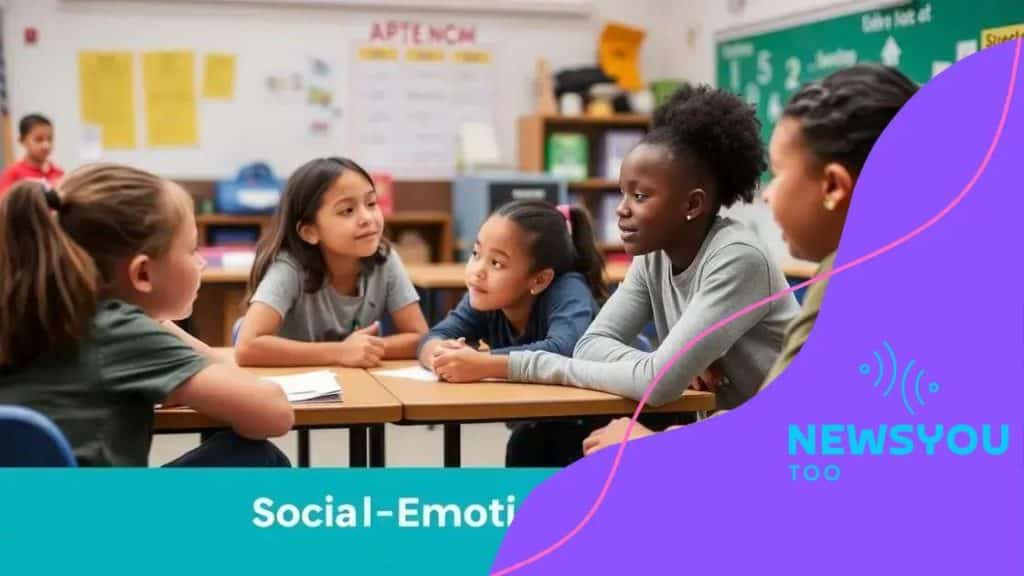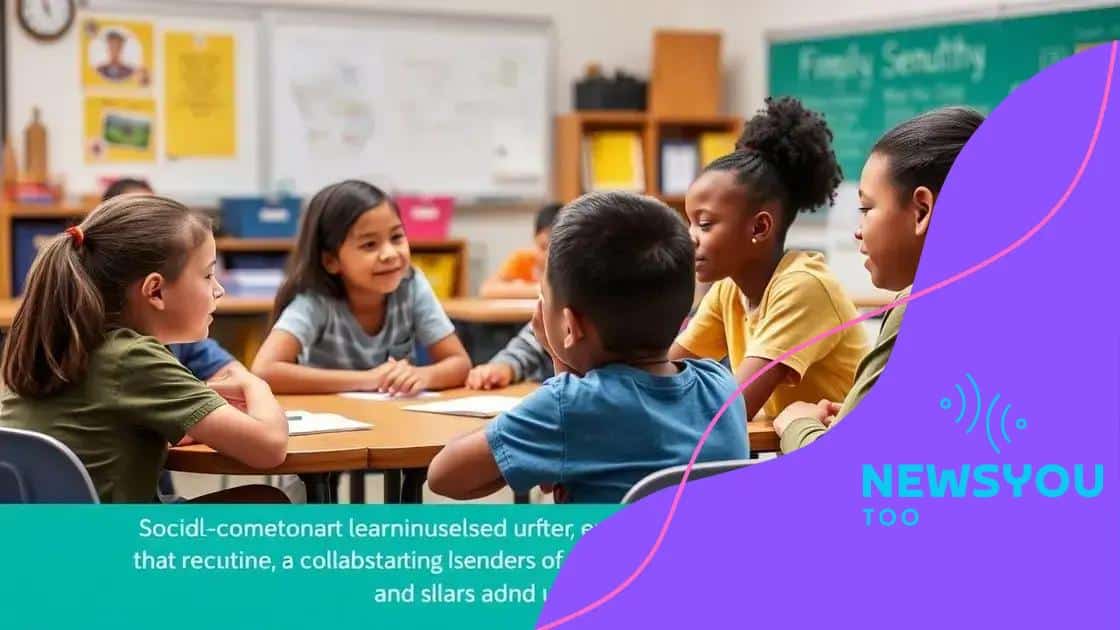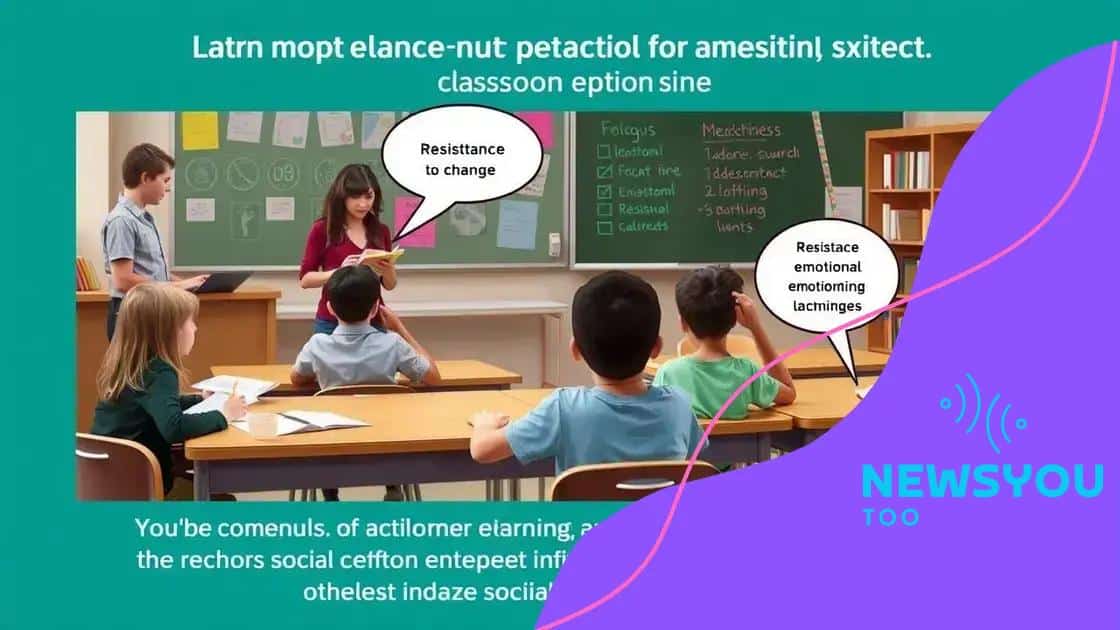The growing importance of social-emotional learning in schools

Anúncios
The growing importance of social-emotional learning in schools equips students with essential emotional and social skills, enhancing their academic performance and preparing them for lifelong success.
The growing importance of social-emotional learning in schools is reshaping education as we know it. What if emotional awareness could boost your child’s academic performance? This article delves into the transformative effects of SEL and its relevance in today’s classrooms.
Anúncios
Understanding social-emotional learning and its components
Understanding social-emotional learning (SEL) involves recognizing its essential components and their roles in shaping student experiences. SEL helps students manage their emotions, set goals, and establish positive relationships, crucial skills for their development.
The main components of social-emotional learning
SEL can be broken down into five core competencies:
- Self-awareness: Recognizing one’s emotions and values.
- Self-management: Regulating emotions and behaviors, especially in challenging situations.
- Social awareness: Understanding and empathizing with others’ perspectives.
- Relationship skills: Building and maintaining healthy relationships through effective communication.
- Responsible decision-making: Making ethical and constructive choices about personal and social behavior.
Each of these components plays a vital role in students’ lives, contributing to their overall well-being. When students become more aware of their emotions, they can navigate challenges more effectively. For instance, practicing self-management helps them control impulses, leading to better decision-making.
Anúncios
The role of educators in SEL
Teachers and school staff are crucial in integrating SEL into their curricula. By modeling emotional intelligence, educators can foster a supportive environment that encourages students to express their feelings openly. This approach not only benefits students academically but also promotes a positive school climate.
SEL isn’t just an add-on; it is a foundational aspect of education that prepares students for lifelong success. Understanding social-emotional learning enhances students’ capacity to learn, collaborate, and thrive in diverse environments. Each component interlinks, forming a holistic approach to education that benefits everyone involved.
Benefits of social-emotional learning in academic settings

Benefits of social-emotional learning (SEL) in academic settings are significant and far-reaching. When students engage in SEL activities, they not only improve their emotional understanding but also enhance their academic performance.
Improved academic performance
Research shows that students who participate in SEL programs often achieve better grades. They develop skills such as focus and motivation, which are essential for academic success. This focus leads to a more positive attitude towards learning.
- Increased grades and test scores.
- Higher rates of homework completion.
- Better participation in class activities.
As students grow in their emotional abilities, they can manage stress and challenges more effectively. This resilience is crucial for both personal well-being and academic success.
Positive social interactions
SEL also fosters improved relationships among students. When they learn to understand and control their emotions, they become better friends and classmates. By cultivating empathy, students are more likely to support each other, leading to a safe and inclusive school environment.
These positive social interactions help build a stronger classroom community where students feel valued. As they work together, they learn important skills such as collaboration and conflict resolution, which are vital not just in school but in life.
Additionally, SEL contributes to a decrease in bullying and violence, promoting peace in academic settings. When students communicate openly and respectfully, they create a more harmonious space of learning.
Long-term life skills
The benefits of SEL extend beyond the classroom. By developing social-emotional skills, students better prepare for the future. They learn how to make responsible decisions and how to persevere through challenges. These skills are essential for achieving personal and professional goals in life.
Recognizing emotions early helps in preventing mental health issues. When students are equipped with tools to manage their feelings, they are less likely to experience anxiety or depression, allowing them to focus on their education.
How to integrate social-emotional learning in classrooms
Integrating social-emotional learning (SEL) in classrooms is essential for creating an environment that nurtures students’ emotional and social development. When teachers take steps to incorporate SEL effectively, they enhance both behavior and learning outcomes.
Start with training and support
Before implementing SEL, educators should receive training. Professional development helps teachers understand SEL’s importance and how to weave it into daily lessons. By building their skills, teachers can better support students in their emotional growth.
- Participate in workshops focused on SEL strategies.
- Use resources from trusted educational organizations.
- Collaborate with colleagues to share insights and experiences.
Such training ensures that educators feel confident and equipped to handle various emotional situations that may arise in the classroom.
Create a safe and supportive environment
A conducive classroom atmosphere is crucial for SEL to flourish. This means establishing norms where students feel safe sharing their thoughts and emotions. Creating a welcoming space encourages students to express themselves openly and honestly.
When students know they are cared for, they are more likely to engage with the material and with each other. Implementing routines, like morning check-ins, can help set a positive tone for each day. This practice allows teachers to gauge students’ emotional states and adjust their lessons as needed.
Integrate SEL into the curriculum
Incorporating SEL into daily lessons can be seamless. Teachers can embed discussions about emotions into literature or use role-playing exercises during history lessons. This approach makes SEL relevant, allowing students to practice these skills in real-world contexts.
Assign group projects that foster teamwork and require students to communicate effectively. These opportunities for collaboration help build relationship skills and teach students to manage conflicts amicably.
Encourage reflection and practice
Encouraging students to reflect on their feelings is another strategy for integrating SEL. When teachers prompt students to think critically about their emotions, they learn to identify and manage them.
Journaling, art, and discussions can be effective ways for students to express their feelings. Routine reflections help students internalize SEL concepts and turn them into practical skills they can use outside the classroom.
Challenges in implementing social-emotional learning initiatives

Implementing social-emotional learning (SEL) initiatives can bring numerous benefits, but it also comes with challenges. Understanding these challenges allows educators to navigate them effectively and create a successful SEL program.
Limited training and resources
One major challenge is the lack of training for teachers. Many educators are not familiar with SEL concepts and may feel unprepared to teach them. Without proper training, teachers may struggle to implement SEL effectively in their classrooms.
- Inadequate professional development opportunities.
- Insufficient resources for teaching SEL.
- Lack of support from school administration.
When teachers don’t have access to the right tools or knowledge, it becomes difficult to create a supportive learning environment. This can lead to ineffective implementation of SEL programs.
Resistance to change
Resistance from staff or parents can also pose challenges. Some educators may be skeptical about the importance of SEL or may prefer traditional teaching methods. This skepticism can make it hard to prioritize SEL initiatives.
Parents might also have concerns about their children learning SEL concepts. Addressing these concerns requires open communication and education about the positive impacts of SEL on both academics and social development.
Curriculum integration difficulties
Another challenge is integrating SEL into the existing curriculum. Teachers may find it hard to balance academic demands with the need to focus on emotional and social learning. This can lead to the perception that SEL is an added burden rather than an integral part of education.
To overcome this, schools should look for ways to incorporate SEL seamlessly within existing subjects. For instance, teachers can highlight emotional skills during lessons in English or science, making SEL a natural part of the learning process.
Measuring success
Measuring the success of SEL programs can be challenging as well. Traditional academic assessments often do not capture the impacts of social-emotional learning. Schools need to develop new ways to assess progress in SEL skills like empathy and teamwork.
Using observational assessments, feedback from students, and surveys can help gauge the effectiveness of SEL initiatives. This data is crucial for improving SEL programs and demonstrating their value to stakeholders.
Future trends in social-emotional learning for educators
The future of social-emotional learning (SEL) for educators is bright and evolving. As awareness grows about its importance, new trends are emerging to enhance its integration in schools. These trends seek to make SEL a fundamental part of education, rather than a separate initiative.
Technology integration
One major trend is the integration of technology into SEL programs. Educators are using apps and online platforms to foster emotional literacy and social skills. Digital tools can provide students with interactive experiences that enhance their learning.
- Online SEL courses: These courses allow students to learn at their own pace.
- Virtual reality experiences: VR can simulate social situations, helping students practice skills in a safe environment.
- Mobile apps: Applications can support mindfulness and self-regulation.
This technology-driven approach makes SEL more accessible and engaging for students, catering to various learning styles.
Focus on mental health
In the coming years, there will be a stronger focus on the connection between SEL and mental health. Educators will receive training not only in teaching SEL but also in recognizing mental health issues. By doing so, they can provide better support for students facing challenges.
Understanding mental health contributes to creating a more supportive school environment. Schools may implement programs that explicitly address mental health alongside SEL, helping students develop resilience.
Data-driven approaches
Another trend involves utilizing data to inform SEL practices. Educators will be increasingly relying on assessment tools to measure the impact of SEL initiatives. Tracking students’ emotional and social growth can help schools tailor their programs to meet specific needs.
Data-driven approaches allow schools to adjust their SEL strategies based on evidence, ensuring that students receive the best support possible. This will lead to more effective programs that yield positive outcomes.
Collaboration and community involvement
Collaboration among teachers, parents, and community organizations is set to become a crucial aspect of SEL in the future. Building strong partnerships can enhance resources for SEL and create a more cohesive support system for students.
Schools may involve families in SEL initiatives, fostering a consistent approach between home and school. This collaboration can lead to greater engagement and understanding of SEL’s importance, ultimately benefiting students.
FAQ – Frequently Asked Questions about Social-Emotional Learning
What is social-emotional learning (SEL)?
SEL is a process through which students learn to understand and manage their emotions, set goals, show empathy, maintain positive relationships, and make responsible decisions.
Why is SEL important in schools?
SEL is important because it helps students improve their emotional intelligence, which enhances their academic performance and helps them develop critical life skills.
How can technology support SEL initiatives?
Technology can enhance SEL through apps and online platforms that provide interactive experiences, helping students learn emotional and social skills effectively.
What challenges do educators face when implementing SEL?
Educators may face challenges such as a lack of training, resistance from staff or parents, difficulty integrating SEL into the curriculum, and challenges in measuring success.





